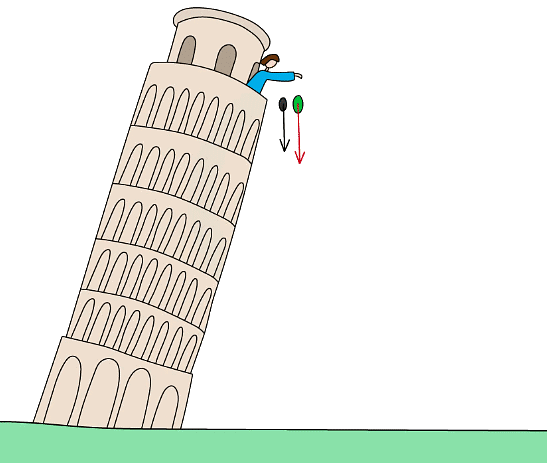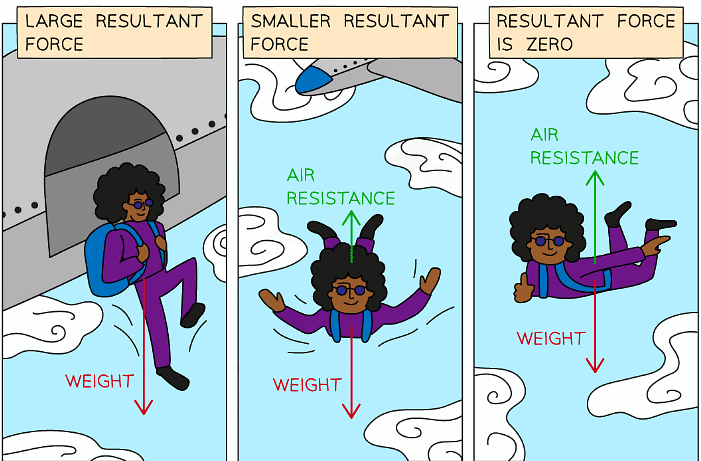Terminal Velocity | Physics for Grade 10 PDF Download
| Table of contents |

|
| Freefall |

|
| Terminal Velocity |

|
| Exam Tip |

|
| Solved Example |

|
Freefall
- In the absence of air resistance, all objects fall with the same acceleration
- This is called the acceleration due to gravity:
g = acceleration due to gravity = 9.8 m/s2 In the absence of air resistance, Galileo discovered that all objects (near Earth's surface) fall with an acceleration of about 9.8 m/s2
In the absence of air resistance, Galileo discovered that all objects (near Earth's surface) fall with an acceleration of about 9.8 m/s2 - This means that for every second an object falls, its velocity will increase by 9.8 m/s
- The symbol g also stands for the gravitational field strength, and can be used to calculate the weight of an object using its mass:
weight = mass × g
Terminal Velocity
- When a skydiver jumps out of a plane, two forces act:
- Weight (due to gravity)
- Air resistance (due to friction)
- The resultant force on the skydiver decreases as they fall. This is illustrated in the image below:
 Debbie initially accelerates downwards due to her weight. The upwards air resistance increases as she falls until it eventually grows big enough to balance the weight force
Debbie initially accelerates downwards due to her weight. The upwards air resistance increases as she falls until it eventually grows big enough to balance the weight force - Initially, the upwards air resistance is very small because the skydiver isn't falling very quickly
- As they speed up, the air resistance increases, eventually growing large enough to balance the downwards weight force
- Once air resistance equals weight, there is no longer any resultant force
- Therefore, the skydiver's acceleration is zero - they now travel at a constant speed
- This speed is called their terminal velocity
Exam Tip
The force of gravity on an object is called its weight. If you are asked to name this force, use this word: don't call it 'gravity', as this term could also mean gravitational field strength, and so might be marked wrong. Additionally, remember to identify air resistance as the upwards force on a falling object. This force gets larger as the object speeds up, but the weight of the object stays constant. Don't confuse 'air resistance' with 'air pressure' - these are two different concepts!
 |
Download the notes
Terminal Velocity
|
Download as PDF |
Solved Example
A small object falls out of an aircraft. Choose words from the list to complete the sentences below:

(a) The weight of an object is the force of __________ which acts on it.
(b) When something falls, initially it ____________.
(c) The faster it falls, the larger the force of ______________ which acts on it.
(d) Eventually it ______________ when the force of friction equals the force of gravity acting on it.
Part (a)
(i) The weight of an object is the force of gravity which acts on it.
(ii) The weight force is due to the Earth's gravitational pull on the object, so weight is due to gravityPart (b)
When something falls, initially it accelerates.
(ii) The resultant force on the object is very large initially, so it accelerates
(iii) This is because there is a large unbalanced force downwards (its weight) - the upward force of air resistance is very small to begin withPart (c)
The faster it falls, the larger the force of friction which acts on it.
(i) The force of air resistance is due to friction between the object's motion and collisions with air particles
(ii) Air particles try to slow the object down, so air itself produces a frictional force, called air resistance (sometimes called drag)Part (d)
Eventually it falls at a steady speed when the force of friction equals the force of gravity acting on it.
(i) When the upwards air resistance grows enough to balance the downwards weight force, the resultant force on the object is zero
(ii) This means the object isn't accelerating - rather, it is moving at a steady (terminal) speed
|
124 videos|149 docs|37 tests
|




















